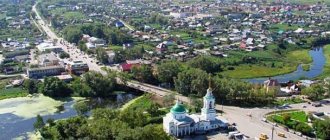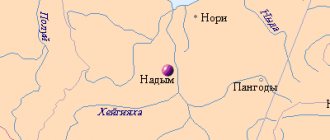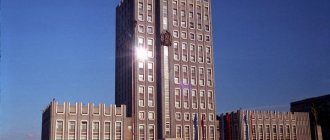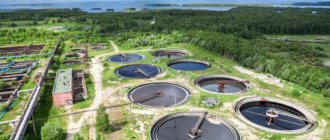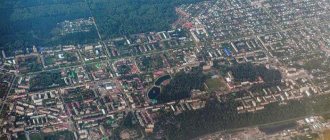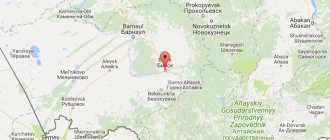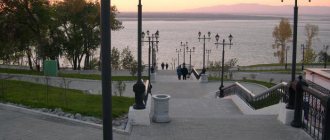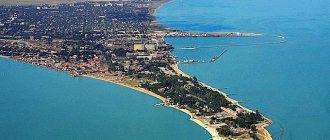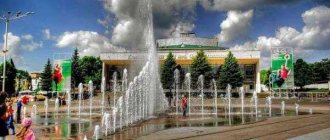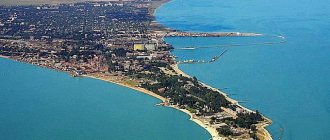Year founded: 1871
Ivanovo (Photo: gradnevest.ru)
Ivanovo
- the center of the Ivanovo region of the Russian Federation, located on both banks of the Uvod River.
In 1871, the village of Ivanovo merged with Voznesensky Posad, the city was named Ivanovo-Voznesensk. The Patriotic War of 1812 helped in the development of the textile industry in the city. Since the manufactories burned down in the Moscow fire, and after the war the demand for fabrics increased, Ivanovo enterprises increased production.
The Shchudrovskaya tent is the first building of the administration of the village of Ivanovo. In the 19th century, Ivanovo-Voznesensk was the largest center of light industry in Europe. During the revolution of 1905, the first Soviet of Workers' Deputies in Russia was formed in the city. In 1929, a decision was made to form the Ivanovo industrial region, uniting the Vladimir, Kostroma and Yaroslavl provinces.
In December 1932, by resolution of the Central Executive Committee of the USSR, the city of Ivanovo-Voznesensk was renamed the city of Ivanovo. During the Second World War, the journey of the legendary Normandie-Niemen air regiment began in Ivanovo. During the war years, Ivanovo factories clothed 12 million soldiers.
Ivanovo is not only a textile center, the city is famous for its educational institutions. The first men's real school appeared in Ivanovo-Voznesensk in 1873, the first women's pro-gymnasium in 1878. The first universities (Ivanovo-Voznesensk Polytechnic Institute and Ivanovo-Voznesensk Pedagogical Institute) were opened in 1918.
House-ship
Currently, more than ten universities operate here. The modern city of Ivanovo is a large cultural and industrial center; the city is famous not only for the textile industry, but also for the production of excavators, truck cranes, and drilling rigs.
By Decree of the President of the Russian Federation dated July 2, 2022, Ivanovo was awarded the honorary title of Russian Federation for the significant contribution of city residents to achieving Victory in the Great Patriotic War of 1941–1945, ensuring uninterrupted production of military and civilian products at industrial enterprises, and for the massive labor heroism and dedication shown. Federation " City of Labor Valor"
».
Attractions
Ivanovo: Shchudrovskaya tent - the oldest brick building in the city, the wooden Church of the Assumption, quaint houses: a ship house, a horseshoe house. The city is part of the Golden Ring of Russia.
Interesting
, that Ivanovo is called the “city of brides”, since a large number of women work at its enterprises.
The city has a population of approximately 400 thousand people (as of 2022).
Day of the city
in Ivanovo it is traditionally celebrated in May.
History of origin
Although City Day in Ivanovo is celebrated on the last Sunday of May, the exact date of its foundation remains unknown. The city of brides was originally a simple village. The settlement between two rivers has been a hereditary land holding for many villages for three centuries, some of which still exist today. For example, Stromikhino, Afanasovo, Golyakovo, Lomy, Zhukovo, Glinishchevo.
The first written mentions of the city of Ivanovo date back to the mid-sixteenth century. The village was a gift from Ivan the Terrible to his wife's brother. That is, the first owner and recipient of the royal gift was Prince Mikhail Temryukovich.
An inventory from the thirtieth year of the seventeenth century suggests that Ivanovo was a village that received its main income from production and trade. A component of the settlement was also a monastic settlement called “Pitykino”. Near it begin the modern streets of Ivanovo - Krutitskaya and Sovetskaya. In total, there were one hundred and twenty-three farms in the village, of which thirty-four were empty. The latter were formed as a result of the devastating raids of the Polish-Swedish invaders. The Polish gentry mercilessly plundered the village, but the population of Ivanovo showed themselves to be patriotic, because the residents defended themselves very courageously.
How the city of Premoguchiy Ivanovo stands on the stinking Uvodi
Improved floodplain of the Uvod River. On the left is the old circus building.
The city of Ivanovo stands on the banks of the Uvod. This is a fairly large river, the left tributary of the Klyazma, cheerful and picturesque. And in pre-revolutionary times, the river was dirty and smelly: most of the factories in Ivanovo-Voznesensk were located on its banks, and the river waters were poisoned with waste from the dyeing and bleaching industries. This circumstance is “immortalized” in an old workers’ ditty:
Like on Uvodi Vonyuchaya there is a city called Premoguchy - Ivanovo-Voznesensk, Ivanovo-Voznesensk
Poltoratsky V.V. Road to Suzdal. M., 1971, p. 91.
Source: M. V. Gorbanevsky, V. Yu. Dukelsky - Through the cities and towns of the “Golden Ring”
New owners
In the seventy-first year of the sixteenth century, the owner of the estate, Mikhail Cherkassky, was executed. The Skopin-Shuisky princes became the new owners. Sixty years later, Ivanovo passed to Prince Ivan Shuisky, who was the tsar’s brother. But the city of brides did not remain in the possession of this owner for long. Eight years later he died, but still managed to leave a will, according to which the village was to go to Yakov Cherkassky. However, Ivanovo was mortgaged to the Suzdal archbishop, and the prince, before assuming the rights of the heir, had to redeem it. Over the next hundred years, the village was under the rule of the Cherkassky family. They were replaced by the Sheremetyev counts, who ruled the village for one hundred and twenty years.
The population of Ivanovo at that time was eight hundred inhabitants who lived in three hundred households. The main occupation of the people was the production of textiles and the sale of related goods. The population of Ivanovo briskly traded in canvas, dyed goods and prints at the surrounding bazaars and fairs.
Boyar estate
Even before the start of the Time of Troubles, the places around Kokhma belonged to the influential princes Skopin-Shuisky. In the 16th century, the Intercession Monastery was founded here. It is believed that the famous commander Mikhail Vasilyevich Skopin-Shuisky spent his childhood in this region. The history of the city of Ivanovo is a typical example of a peasant town on the periphery of the Russian state. Local residents were engaged in the manufacture and dyeing of flax fabric, from which canvases were made. Agriculture here was poorly developed due to low-fertility soils.
Under Tsar Mikhail Fedorovich, a census was carried out, information about which was preserved in the sources. Thanks to such documents, the history of the city of Ivanovo is being reproduced today. In the first half of the 17th century there were more than a hundred courtyards here, which is a considerable number for such a remote place.
Origins of the textile industry
The development of trade and production was very active. Ivanovo knitwear, which is famous all over Russia, originated at exactly the same time. Buyers decided to expand their sales potential. They were not satisfied with only the local market, and therefore they decided to develop other, more distant places. These were St. Petersburg, Astrakhan, and even Central Asia
Already in that distant time, the population of Ivanovo was famous for its golden hands. We can speak about this with such confidence based on the following fact: English sailors purchased canvas in huge quantities to make ship sails. In the mid-eighteenth century, serf G.I. Butrimov organized the first manual production in the village. His factory was not of a huge scale, and the equipment included only fifty machines. At the same time, Grachev's manufactory appeared outside the village. Its productivity was much higher than the previous one, since it operated hundreds of looms. Currently, on the basis of this production, a cotton mill named after Samoilov has been created.
Although the manufactories were created by different people, they belonged to Count Sheremetyev. In fact, the creators of production were just overseers. Ivanovo knitwear was made both by immigrant peasants, who were released by landowners to earn money, and by local residents who had no other source of income. The most surprising thing was that for the opportunity to engage in a craft, the workers paid the count a fairly high quitrent. It amounted to fifteen rubles per working soul. They took a quitrent in the form of yarn from the fair half. At the same time, the average Russian payments were five rubles. But the population of Ivanovo gave away almost their three months’ earnings.
Manual production of chintz was organized by O.S. Sokov. Initially, the manufactory produced simple printed material on canvas. But the durability and brightness of the dyes, the wide selection of colors and the unusual designs were excellent. Perhaps this was due to the fact that the founder of the manufactory, Sokov, was an artist-carver. In the process of development, the production began to engage in printing on cotton fabrics. It gave rise to the mass production of chintz.
At that time, the streets of Ivanovo were full of workshops and heated huts. More prosperous peasants organized entire mini-factories for the production of heel prints. By the end of the eighteenth century there were about twenty of them in the village. Over time, production scales grew, and enterprises turned into entire manufactories. Around the same time, the textile industry was repurposed. Factories began to produce cotton and calico fabric instead of linen. Initially, the production worked on imported fabric, and then only foreign yarn was used to produce calico and chintz.
The Patriotic War of 1812 gave a big impetus to the development of manufactories. Since similar Moscow factories were destroyed, their place was taken by Ivanovo ones. After all, who, if not they, should have supplied the entire destroyed state with fabrics. For local entrepreneurs it was a “gold mine”. All existing manufactories expanded, and many new factories arose. Against the backdrop of the war, a powerful production breakthrough occurred. Technologies and methods for processing cotton fabric have been constantly improved. The welding method of dyeing was introduced into weaving. In terms of trade and handicrafts, Ivanovo surpassed all settlements in the Vladimir region.
Museums Ivanovo
Article: Museums of Ivanovo - past and present of the “city of brides”
Textile manufactories have been operating in the city for a long time, so one of the most popular museums is dedicated to Ivanovo chintz. It was opened in 1987 in the old mansion of the manufacturer and philanthropist D. G. Burylin. Museum collections tell about textile production technologies from ancient times to the present day. One of the sections is dedicated to a native of Ivanovo, the famous Russian fashion designer Vyacheslav Zaitsev.
Tourists who want to get acquainted with the history of the city come to the local history museum. Its holdings include more than 780 exhibits - unique archaeological finds, weapons, numismatics, books, paintings and objects of decorative and applied art.
The building of the Ivanovo Calico Museum
Travelers interested in the history of cars check out the Museum of the Soviet Automotive Industry, which was opened in 1992 on the basis of a local auto repair plant. Airplane lovers are regulars at the Ivanovo Museum of Military Transport Aviation.
Tourists who come to the city with children like the School of Crafts museum. In its halls you can see items of women's handicrafts, folk toys, an exhibition of samovars, teapots and cups.
In the Ivanovo State Museum of History and Local Lore. D. G. Burylina
Capitalist peasants
While some, the so-called “wealthy peasants,” filled their wallets, others lived below the poverty line. The workers were directly dependent on the owners of the “calico kingdom.” The rent increased steadily. By the thirtieth year of the nineteenth century, its size was equal to forty-five rubles per worker. It was impossible to evade or ask for a delay. Debts were recovered by any means. Some owners of textile enterprises asked permission from the landowner and bought plots from the peasants. It was normal to support up to a thousand people who were not involved in production, but maintained order and ran the household.
The first person to live in this way was the manufacturer Grachev. In order to be equated with the Moscow merchants, he paid Count Sheremetyev. He had to pay one hundred and thirty-five thousand rubles for his freedom. He inspired many factory owners to do the same, from whom the landowner received huge sums. Before the abolition of serfdom, this was very relevant, and the count earned about a million from such transactions.
But even after gaining freedom, the “wealthy peasants” were left with an empty trough. Sheremetyev agreed to the deal only on the condition that he retained the right to own real estate. And since paying rent for industrial buildings was unimaginably expensive, manufacturers began to buy land. They transferred their production to them, and such areas were called settlements. They were erected and expanded very quickly, and soon began to unite. Such cooperatives were transformed into urban-type settlements. At that time they were called posads. The factory owners sought to get rid of the influence of the Sheremetyev family and thereby move the center of market trade to themselves - to Voznesensky Posad.
Industrialization of production
The nineteenth century was special for the textile industry for another reason. It was in this century that the industrial revolution took place. Manual labor was replaced by cylinder calico printing machines, a steam engine, and mechanical weaving looms. Industrialization meant that by the middle of the century, seventy-five percent of fabrics were sold from machines. The textile industry went into mechanical mode.
Thanks to this industrial boom, on July 21, 1871, the Committee of Ministers adopted a Regulation according to which the village of Ivanovo and Voznesensky Posad were united. The settlements were assigned the status of a city without a district, called Ivanovo-Voznesensk and located in the Vladimir province. Ivanovo's economy was characterized by stability thanks to textile factories, paper spinning and weaving mills, chemical and mechanical plants. Almost everyone was employed in the production sector. The number of inhabitants increased steadily, and the population of Ivanovo amounted to over ten thousand people.
Establishment of Bolshevik power
After the abdication of Nicholas II, dual power was established in Ivanovo, which was typical for most of the country. On one side was the Council of Workers' Deputies, and on the other were representatives of the Provisional Government. At first, the influence of the Socialist-Revolutionaries and Mensheviks was great in the city. When re-elections to the local Soviet took place in the summer, the majority of seats in it were taken by the Bolsheviks. They were ready for the news of the October revolution in Petrograd and immediately created a revolutionary headquarters. The Civil War hardly affected these places. Power passed to the Bolsheviks without any bloodshed, and the whites never reached the city.
In 1918, the Ivanovo-Voznesensk province was created. It became the center of the textile industry of Soviet Russia. The Bolsheviks created a new federal subject based on its economic independence and isolation from neighboring provinces. The new status immediately affected the life of the city. Pedagogical and polytechnic institutes were founded there. New schools, medical institutions, museums and libraries began to appear. In the 20s its own water supply system was opened, followed by public transport in the form of buses.
New textile factories attracted workers from neighboring regions to the city. Among them there were many women who worked as seamstresses, etc. Therefore, in Soviet times, Ivanovo received the popular name - “the city of brides.” Local authorities quickly got rid of everything that could resemble the tsarist era. Therefore, in 1932, Ivanovo-Voznesensk was finally renamed Ivanovo. The former toponym bore the imprint of former Orthodox religiosity and irritated the Bolsheviks.
Economy and industry
But time passed. Now the city of Ivanovo, unlike in previous years, does not shine with its industrial potential. The settlement, like the entire region of which it is the administrative center, is a region living on subsidies. At the moment, many textile giants have simply been liquidated.
Today, offices, shopping centers, warehouses, supermarkets and shops have been built in the premises of former factories and combines. But, despite everything, the city remains the textile capital. It does not bring the former profit and glory, but still on the territory of Ivanovo there are sewing workshops that produce finished products. Travel companies that organize interesting tours make money very actively from textile production. The main target audience is residents of neighboring cities. The point of the trip is that tourists are taken to the center of Ivanovo, where the largest retail outlets are located. These are, for example, “Textile-Profi”, “Rio”, “Textile-Max”. This shopping tour is very popular; people are happy to buy high-quality Ivanovo textiles.
In addition to light industry, heavy industries also function well in the city. They managed to stay afloat after the collapse of the Soviet Union. These include:
- heavy machine tool manufacturing plant;
- machine-building enterprise "Crane";
- "KRANEKS";
- carding machine factory.
Working in the city of Ivanovo in the heavy industry is considered prestigious. This is due to the fact that they pay relatively decent salaries and provide workers with a full social package. The food sector is also well developed in the city. This is an enterprise in Ivanovo, such as a brewery, as well as a dairy factory and a meat processing plant.
After Me, Ivanovo is dying out
In 2005, the presidential administration decided that the vice-mayor of Moscow, Mr. Mikhail Men, should be nominated for the governorship of the Ivanovo region. The gullible people of Ivanovo fell for the name. Priest Alexander Men, the father of the appointed governor, was for many a man of high spirituality and liberal principles and, it was thought, was the way he raised his son - a musician, esthete, philosopher, director and father of many children.
Today, the “Ivanoids,” as Mikhail Men called them, that is, Ivanovo residents, summing up the results of the ambiguous management of the region, feel disappointed... When in 2013 Men left the governor of the Ivanovo region to become the minister of construction, there were publications in the media, both local and federal , who talked about how Mikhail Alexandrovich “raised” the Ivanovo region “from its knees.” But in reality this turned out to be a myth. There were also positive aspects in My activities, but the region under his leadership was never able to overcome the deepest crisis - economic and moral - into which it found itself with the collapse of the USSR. To understand this, it is enough to compare the indicators of economic development of the Ivanovo region when Me came to the region (2005) and in the last year of his “enlightened reign”. The article was written based on materials published in the media, and the figures refer to the end of Mr. Men’s work in the Ivanovo region.
The region's potential fell by 75 percent
Bankruptcies, hostile takeovers, or even just raider takeovers - this is the situation with industry in the Ivanovo region over the past years. As a result, a twofold reduction was recorded in industrial products, and a one and a half times reduction in textile production. In the mechanical engineering industry, the production of Ivanovets truck cranes, tower cranes, and excavators has decreased significantly - apparently, soon there will be no more of them, it seems that judicial debt collection is underway. The production of multi-operational machines with numerical control, the pride of the USSR, supplied to many European countries, has practically ceased (most likely the reason is bankruptcy), as well as the products of the largest testing equipment plant in Europe for testing materials for mechanical characteristics (apparently, a case of fraud has been opened in especially large sizes).
By the way
According to RIA “Rating”, the Ministry of Regional Development and the St. Petersburg Politics Foundation, at the end of 2013, the Ivanovo region ranked ahead in Russia:
— 83rd place out of 83 regions in terms of the volume of the real sector of the economy;
— to 81st place in the investment attractiveness rating;
— in 79th place in terms of the family’s cash balance after carrying out minimum expenses (in terms of the standard of living of families);
- 76th place in terms of average nominal wages.
Textile engineering has long ago given its soul to God - the equipment has long been melted down. Production in the chemical industry has almost halved. The production of certain types of food products has decreased significantly, the production of alcohol has been completely stopped - it seems that the largest distillery in Russia is standing - and one of the largest oil extraction plants in Russia in the city of Shuya (sold to competitors, who probably used the plant for spare parts). Something incomprehensible is happening with the candy factory: the finished production, apparently, cannot begin to work. Instead of the largest textile mills, automatic factories - the pride of Soviet industry - there are now shopping centers, warehouses or empty workshops behind high fences.
On this topic
10722
“Gusinsky “burnt out” on his show-offs”
How the Security Service of the President of the Russian Federation worked in the 90s
One cannot ignore the very strong “smell” of the ex-governor’s possible personal interest in the areas where real money was circulating: bankruptcies of enterprises and their resale to other, “right” hands, sales of municipal property
As a result, the current industrial potential of the Ivanovo region is only 25% of the potential of Soviet times. The number of people employed in the sphere of material production has more than halved. More than 91 thousand Ivanovo residents today work in other regions. The region has lost 75% of its industry and 19% of its population since 1989. In the textile industry, out of 70 production facilities operating in the 80s, 32 remain, and, as a rule, these are production facilities mainly engaged in finishing.
The most valuable thing is people?
Researchers from the University of California predicted that by the end of the century Ivanovo will disappear. Probability – 75%, reason – population decline. In total, scientists named seven cities around the world that will not exist by the end of the century, and only one of them is in Russia: the center of the Ivanovo region - Ivanovo. Ivoblstat confirms disappointing forecasts: in 2012, the population continued to decline and decreased by 0.5% (5053 people), women in the region then lived for 73 years, men - 60 years: they did not have time, poor fellows, to enjoy an average pension of 9233 rubles at a subsistence level minimum 6544 rubles. Even according to the calculations of the cautious Ivoblstat, by 2030 the population will still decline: in rural areas - by 22.2%, in cities - by 7.8%.
A year earlier, in 2011, mortality exceeded the birth rate by 1.6 times! 11 thousand people were born in the region, and 18 thousand died. If we compare the 2005 census data with modern indicators, the numbers will be completely terrifying. According to the 2005 census, the population of the region was 1114.9 thousand people, and in 2015 there were only 1036.9 thousand residents left. Loss – 10% in 10 years! By the way, in the Ivanovo regional statistics there is a dynamics of changes in the number of residents of the region since 1926. And if we rely on the population size in the region as an indicator of the state of affairs in the region, then in the 21st century the worst times have come there.
Why are the people of Ivanovo dying out? The main reasons are alcoholism, drug addiction, low income and poor environment. In 2012, the average salary in the region was 16.4 thousand, while the average salary in the Central Federal District (CFD) was 22.5 thousand rubles. The majority of the population spent most of their money on paying for food and housing and communal services. 200 thousand people, that is, 20% of the population, had incomes below the subsistence level. And at the same time, the population of the region spent 5.5 billion rubles on legal and 2.5 billion on illegal alcohol...
As a result, at the end of 2010, more than 36 thousand patients with alcoholism and alcoholic psychoses were registered, which is twice (!) the all-Russian specific indicator, and in 2013 there were already 41,350 such patients.
From 2000 to 2010, the number of chronic alcoholics increased by 30%. At the same time, women alcoholics in the region make up about 30% of the total. It is not surprising that alcohol is the cause of divorce in 60–80% of cases. Alcoholics are 37 times more likely to have children with abnormalities than abstainers; 60% of children born to drunken mothers do not live to see one year of age. In 2000, the Ivanovo region was included in the group of regions with consumption of 17.1 liters of vodka per capita, while it is believed that personal degradation begins with 8 liters per year. In recent years, according to some data, vodka consumption in the region is 29 (!) liters of alcohol per capita.
In terms of drug addiction, the Ivanovo region was included in the list of regions of the Central Federal District, where the level is characterized as a social catastrophe; here the Ivanovo region has a disgraceful 3rd place after the Moscow and Voronezh regions.
In August 2015, Deputy Prime Minister for Social Affairs Olga Golodets visited Ivanovo. Before her arrival, Ivoblstat released figures: in the Ivanovo region in the first half of 2015, 8,510 people died from alcoholism, which is 37 people (or 0.4%) less than in the same period in 2014. The mortality rate in the Ivanovo region is now lower than in the Russian Federation and the Central Federal District as a whole: mortality rates from diseases of the circulatory system, for example, in the Ivanovo region are 622.3 per 100 thousand people, in the Central Federal District - 710.4 per 100 thousand people, in the Russian Federation – 680.4 per 100 thousand people. In a year and a half, mortality rates in the region suddenly became not as egregious as before...
On this topic
2628
The most in-demand professions after the coronavirus pandemic are listed
After the end of the coronavirus pandemic, professions related to remote provision of services and delivery will remain the most in demand. No less popular will be professions in the field of medicine, manufacturing and digitalization of work processes.
Despair kills
Today it has been established that more than 100 “popular” diseases, including almost the entire list of “Ivanovo” diseases, are manifestations of psychological dissatisfaction. Long-term stress is the cause of diseases of the circulatory system, diabetes, diseases of the musculoskeletal system, obesity, etc., acute stress leads to hypertensive crises, thrombocytosis, heart failure, strokes, etc. Alcoholism and drug addiction are also often a way to escape stress.
One of the causes of stress is unemployment, and in recent years it in the region was 10–15% higher than the average for the Russian Federation and amounted to about 6% (35 thousand people). The number of marriages and divorces cannot be called optimistic: in 2012 – 3400 and 1800, from January 1 to April 30, 2011 – 1846 and 1420, respectively. There are 1,229 women per 1,000 men, and in Ivanovo half of the women are single, and many women cannot have children due to abortions, 80% of women in labor are sick, and 1% of them are HIV-infected... And how can something that For every child born there is (officially) one abortion (10-11 thousand abortions)? It is believed that there are two to three times more actual abortions, and among the children born, only 40% are healthy.
In the region, about 200 suicides and 400–500 suicide attempts occur annually, with an increase of 20% annually, which is a sign of obvious psychological distress. For comparison: in the USA there are also 200 suicides a year. True, the population of the USA is 325 million people.
Ecology is a separate pain point for the region. In terms of environmental cleanliness, the Ivanovo region, according to the public organization "Green Patrol", is in 20th place. And the regional city of Ivanovo, according to the Ministry of Natural Resources, is in 11th place in terms of air pollution among 163 cities with a population of more than 100 thousand people. The main contribution to air pollution in Ivanovo was made by the concentration of formaldehyde. Only 31% of the population has benign water, and for 61% it is conditionally benign. In the Ivanovo region, more than 20 million tons of waste have accumulated (!), which mainly accumulated in unauthorized landfills. Every year, more than 400 thousand tons of waste are generated in the region, but no production facilities for processing this waste have appeared in the region during the years of Mr. Men’s governorship.
Subjective reasons
The budget of the Russian Federation is 13 trillion rubles, and the country consumes 3 trillion rubles worth of light industry products. It follows from this that the domestic light industry, which currently occupies only 20% of the Russian market, could become a locomotive of industrialization. This today is hampered by gray imports and gray domestic supplies, which prevent law-abiding textile manufacturers from expanding production due to low prices for their products. The consequence of this was the degradation of Russian light industry. And also the technical backwardness of many industries, the problems of raw materials left abroad after the collapse of the USSR, the problems of lending...
All this has been haunting the Russian light industry since the 90s. And it fully affected enterprises in the Ivanovo region. Result: weak light industry enterprises ceased to exist, strong ones became much weaker. Machine-building enterprises in the Ivanovo region also had big problems in 2005. These were systemically important industries. Governor M.A. came to this region from the post of vice-mayor of Moscow. Men.
Let's be fair, Men received a region with an almost empty budget to lead - the textile kings allowed themselves not to pay taxes, and it was necessary to force them to do it. The budget increased 2.5 times due to better tax collection, and housing construction improved significantly. After investing billions of rubles in the city of Plyos, many more tourists began to travel, a number of small enterprises were built, etc. Several good roads have appeared in the region, the road to Plyos is especially good, where the right people now often go and where the ex-governor has a dacha. Subsidies that reduce the interest rate on loans for cotton purchases have been extracted from the government. Of course, in the region, especially in Ivanovo, they began to build better, and the cities and settlements themselves became cleaner. The region entered several federal target programs and began to receive subsidies for their implementation.
On this topic
6212
The British singer spoke about her kidnapping and rape, after which she refused to perform
British singer Aimee Ann Duffy, known as Duffy, described in detail her abduction and rape, after which she stopped performing and moved around for five years, not feeling safe.
It can also be considered positive that the region has developed a strategy for its development and is taking steps to enter the technical textiles market, although there are a number of very serious risks along this path. The slowdown in the region’s recovery was temporarily stabilized, but here again crisis after crisis...
But in addition to the objective reasons for the slowdown in the economy of the Ivanovo region, it is also necessary to highlight the subjective reasons from the time of Governor Me, which influenced its development. Firstly, there is a complete lack of use of the developments of universities in the region, support and organization of promising industries that are non-traditional for the Ivanovo region. Secondly, the hypertrophied increase in the bureaucracy, which was not involved in production and rather became a brake on it. At the same time, people were placed in key positions who were unsuitable for these positions by education and professionalism, but who often came from the ex-governor’s native places near Moscow. Associated with this was a lack of interest in using the potential of the region’s population, residents’ proposals, and the creation of a system of unsubscribes, which essentially ruined the initiative from the localities and caused damage that cannot be calculated. And, finally, one cannot ignore the very strong “smell” of the ex-governor’s possible personal interest in the areas where real money was circulating (judging by the publications of that Ivanovo press, which was called “venal”): many bankruptcies of enterprises and their resale to others , “necessary” hands, sales of municipal property. For example, the Krasnaya Talka sanatorium with 700 beds in Gelendzhik, occupying most of the coastline of Gelendzhik Bay and nine buildings, was quietly sold, according to my information, which we will definitely check in inquiries and expert assessments in the near future, at a price several times higher less than its 2009 market value. There was also the purchase of land in places where they obviously should become more expensive, maximizing the cost of budget purchases, the inexpensive sale of factory buildings for chain shopping centers, a special interest in the break-even food industry, and a number of other matters that were extremely opaque. Mikhail Me also had one more weakness - church building at the expense of the poor regional budget. And these churches were built, as a rule, in the most inconvenient places.
Apparently, all this, as well as today’s large-scale purge of the Menevsky administrative apparatus, by P.A., who replaced me as Ivanovo governor. Konkov, we will devote a separate article, since the extraordinary personality of Mr. Minister M.A. Me - a musician, director, publisher, president of the Foundation. A. Me, a liberal, a millionaire, a doctor of philosophy, a father of many children, etc. – arouses genuine interest of our readers.
By the way
What is the Ivanovo region today?
Area - 21.5 thousand square kilometers (from north to south - 158 kilometers, from west to east - 230). The population is more than 1 million very patient people. From the regional center - the city of Ivanovo - to Moscow is 275 kilometers. The center of the European part of the Russian Federation, one border is the Volga, the other is Klyazma, only the Kaliningrad region is smaller than the Ivanovo region. Half of the region's area is occupied by forest. Industry: textile and clothing production - 33.5%, mechanical engineering - 28.2% and food production - 17.4%. There is no oil, no gas, no diamonds in the region, but only deposits of peat, sand, clay and phosphorites and its own “Chernobyl” - the result of an unsuccessful underground nuclear explosion in 1971. There are 202 profitable enterprises and 122 unprofitable ones operating in the region today.
Reference
The main causes of mortality in the region are diseases of the circulatory system (41.2%) and neoplasms (12.7%). By 2013, there was an increase in diabetes mellitus (+10%), cancer (an increase of 18% over seven years), tuberculosis (of which about 20% were + HIV), HIV-infected people in the region - 6 thousand people (region - epidemic leader in the Central Federal District, 16th place in the Russian Federation with growth of 10–30% per year). According to the results of clinical examinations during the governorship of Mikhail Men, among young people 25–35 years old in the Ivanovo region, only 23.9% can be considered healthy.
Demographic situation
Changes have also befallen the demographic situation. Social protection of the population of Ivanovo informs that the number of residents of the city has decreased significantly compared to Soviet times, namely the eighties. Then the number of Ivanovo residents reached half a million, now there are much fewer people. The number of local spruce trees reaches four hundred thousand. This decline was influenced by the difficult nineties. The number of deaths began to prevail over the number of newborns. This trend is still relevant today. Although the reduction is not taking place at such a rapid pace as after the collapse of the USSR, it still persists. The slight population growth is not due to local residents, but to the migration of people from other Russian cities and visitors from neighboring countries. In the city you can often meet Armenians, Azerbaijanis, Kazakhs, Turkmen and Uzbeks. Many of them are Russian citizens.
The population of Ivanovo is not so young. The average age of an Ivanovo resident is forty-one years. The number of elderly residents is growing, while the number of working-age people is declining. In terms of the level and quality of life, Ivanovo is far from a leader.
Soviet regional center
During the first five-year plans, Ivanovo also received the status of the “third proletarian capital” after Moscow and Leningrad. This was due to the large number of factories and enterprises opening. At that time, the Soviet leadership planned to move the administrative center of the RSFSR to some other city, while leaving the capital of the USSR in Moscow. Ivanovo was among the “contenders” for this title, although this project was never implemented.
Nevertheless, it was precisely in the 20–30s. the city experienced its biggest boom. Ivanovo was significantly rebuilt. Soviet architects looked at it as a testing ground for their own experiments. Thanks to this, today in the regional center there are many monuments of early socialist constructivism. Other attractions of the city were the country's largest circus and a unique school for children from foreign communist families (Interdom).
The Bolshevik perestroika of Ivanovo did not spare many temples and churches built during the tsarist era. For example, the Intercession Monastery was destroyed, around which at one time a settlement was formed, which later became a regional center. Its building was demolished and the Drama Theater, opened in 1939, was built in its place.
During the Great Patriotic War, Ivanovo was a typical rear city. A lot of hospitals were opened here for Red Army soldiers and evacuated civilians. They often occupied the premises of schools and other public buildings. In 1942, a base was created at the Ivanovo airfield for the French aviation regiment "Normandie-Niemen". Foreign pilots fought on the side of the Soviet Union against the Axis powers. In Ivanovo they lived in separate dormitories.
The city's attractions
Many people know that the most interesting tour of Russian cities “Golden Ring” includes the city of Ivanovo. The sights of this settlement are equal to those of Suzdal, Yaroslavl, Kostroma and Vladimir. Most of the city's memorable places are architectural structures and museums.
It is not the new buildings of Ivanovo that attract the eye, but the buildings of the constructivist era. It was in the thirties of the twentieth century that a monument was erected, which the locals call the “house-ship”. The building, consisting of two buildings, is very unusual in design. The project manager was the capital's architect D.F. Friedman. The central position is occupied by a part consisting of five floors. The façade of the figure faces the square.
The design received such an interesting name due to its resemblance to a ship. The right end of the building, due to its oblique lines, resembles the bow. And a row of glass showcases on the ground floor seems to create a feeling of floating above the earth's surface. If you use your imagination, the balconies will resemble decks and bridges. This monument is perhaps the best example of the art of design of the twenties of the last century. The design demonstrates the latest approaches and solutions.
The emergence of the first manufactories in Ivanovo
Ivanovo-Voznesensk. Factory of the Kuvaevskaya Manufactory Partnership. Postcard beginning XIX century
The next century was marked by the appearance of the first manufactories in the village. Ivanovo grew, occupying both sides of the Potok stream (the name is transparent, does not require explanation) and the Kokuy tract. The last toponym will certainly arouse interest among lovers of history, geography and the native language, especially since Moscow was famous for its Kokuy (Kukui). These names are based on the Russian local geographical term kokuy, which most often means a type of hill, a hill.
On Ivanov’s plan, completed in 1774, you can find interesting toponyms. On the one hand, these are familiar rural microtoponyms: Kruglikha bor, Denezhkina Vyti bor (where Denezhki is an anthroponym, and howl is an ancient, now not used word - “a plot of land or mowing”). On the other hand, there are names that can be found in other Russian cities, in particular in Moscow: Razgulyai, Lousy Hill, Red Pond, Kokuy. There are also names on the plan that have a specific historical background, for example, Kuren and Panskaya streets.
Historical and revolutionary monuments
Historical monuments give the city a special flavor. One of them is the monument to the fighters for the revolution, which is located on Revolution Square. The monument was erected in honor of the picketing workers of the Ivanovo plant. Then, in 1905, the protesters were dispersed with weapons.
The rapidly growing new buildings in Ivanovo could not overshadow people's interest in the city's industrial facilities. This is especially true for the manufactories of the late nineteenth year, because many of them have been preserved in their original form. No one has yet destroyed them, but, however, access to the first textile factories is closed. The most interesting thing is the combination of numerous industries and classical architectural monuments.
The estates of landowners and the houses of wealthy peasants make a huge impression. Most of them belong to the style of classicism in its early version. The mansion of the entrepreneur Dühringer is unusual. The house was built in 1910, and it can most likely be attributed to the Gothic style. It is also noteworthy that in the backyard of many estates there were small workshops or textile mini-factories.
Holidays and festivals
Event tourism is no less popular in the city than excursion and pilgrimage tours. Every winter, for more than 10 years, Ivanovo gathers rock music lovers for the traditional Rock February festival. It is attended by non-professional youth rock bands performing music in different directions - acoustics, vocals, traditional and extreme rock, punk rock and hard rock, alternative and “Neformat”.
On the last Saturday of May, Ivanovo celebrates City Day. All the streets traditionally host many interesting sports and cultural events: theatrical processions, Brides Parade, canupolo games, workout shows, folk souvenir fairs and concerts.
There is even a special historical trolleybus running around the city on this day. And the holiday ends with colorful evening fireworks.
Church of St. George the Victorious
Shchudrovskaya tent
The city of Ivanovo has a large number of memorable places. The sights are mainly of an architectural nature. One of the outstanding architectural monuments is the Shchudrovskaya Tent. This object is one of the oldest buildings in the city, the material for which was brick. The building received this name thanks to its owner, who was a major industrial person, merchant Osip Shchudrov. The tent is located near Revolution Square, that is, in the very center of the village.
Initially, all matters related to the management of the village were decided in this building. That is, the tent was an ordered hut. Directories were kept there, in which the names of the peasants and the amount of quitrent from each were indicated. The smallest room was intended for the clerk. He managed the estate of the Cherkassky family. Due to the fact that the side of the building that faces the modern street, Krasnogvardeiskaya, is more decorated, it is believed that this is where the entrance to the tent was located. The windows located on the facade are bordered with carved figured finishes. This architectural monument is unique of its kind; you won’t find anything similar to it.
The building passed to the owner, whose surname the building bears, at the beginning of the nineteenth century. The merchant decided to make a two-story superstructure and converted the building into a production building. But during the restoration work that was carried out in the seventies and eighties of the twentieth century, the structure was returned to its original appearance.
First mentions
The documented history of the city of Ivanovo began in 1609, when this settlement was first mentioned in the chronicle written in the Trinity-Sergius Lavra. According to this source, a small place was founded by runaway peasants who left their patrimonial monastery villages. In order not to confuse this Ivanovo with other settlements with similar names, it was sometimes called Ivanovo-Kokhomsky (the Kokhma fortress was located nearby).
The first mentions of the village are associated with the Time of Troubles, when Russia suffered from civil war and Polish intervention. Foreign invaders even reached Ivanovo itself. Russia was in a terrible plundered state; the country did not have a strong army that could defeat and drive out the invaders. In 1608–1609 the village was used as a stronghold for the army of Poles, Lithuanians and Cossacks from among the supporters of False Dmitry II. Already in the 20th century, archaeologists discovered within the city the uniforms of that time, made according to Western European models. In 1609 (the year Ivanovo was founded) the village was tiny and remained inconspicuous for some time. But further economic growth made it an important center for textile production.
Church buildings
Among all the architectural monuments, church buildings deserve special attention. Every person who has visited the center of Ivanovo cannot take his eyes off the Vvedensky Convent. It was erected during a difficult period for the country - the collapse of the USSR, that is, in the ninety-first year. Its founder is Archimandrite Ambrose.
An integral part of the monastery is the church. It was built much earlier. The foundation of the memorial site dates back to 1918. The main architect of the project was P. Begen. For a certain period of time, the church was engaged in a completely different type of activity. The State Security Committee located its archive there. The entire building was redone, not a trace remained of the church symbols. The believers went on a hunger strike, they demanded that the building be returned to the Orthodox community. And their efforts were not in vain. The Patriarch of All Rus' heard their call and issued a decree, according to which the Holy Vvedensky Convent was founded.
A distinctive feature of this spiritual center is its active educational and social activities. Nuns are engaged in community service: they visit colonies, help the disabled, the homeless, the sick, and orphans. The monastery has a helpline. Coming to this place, anyone in need will receive support. There are also more ancient church buildings in Ivanovo, for example the Assumption Cemetery Church. However, for unknown reasons, there is not much interest in it.
Population gain or loss according to the census
The total and official population of the city of Ivanovo, how many people live in it as of January 1, 2022, the number of people in each individual urban district and municipality, further in the second table.
| Year | Growth/decrease population city of Ivanovo |
| 2017 | ↘406,933 people |
| 2018 | ↘406 113 people |
| 2019 | ↘405,053 people |
| 2020 | ↘404,598 people |
| 2021 | ↘401,505 people |
| 2022 |
